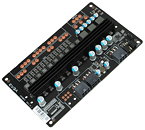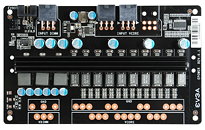Wednesday, January 25th 2012

EVGA Offers Overclockers the $100 EPower Board
EVGA has now released the EPower Board, a VRM board which can be hooked up to a motherboard and/or graphics card (some soldering required) and provide more watts required for uber-overclocking.
This warranty-voiding device features a 10-phase main output, a 3-phase secondary output, digital PWM (for the main output), three 6-pin PCIe power connectors, plus EVBot and fan support. The EPower Board costs $99.99 and is "intended only for advanced users with electronics experience."
This warranty-voiding device features a 10-phase main output, a 3-phase secondary output, digital PWM (for the main output), three 6-pin PCIe power connectors, plus EVBot and fan support. The EPower Board costs $99.99 and is "intended only for advanced users with electronics experience."


31 Comments on EVGA Offers Overclockers the $100 EPower Board
In case it wasnt obvious, check the size of that thing. As "big" as a "small" Graphics Card.
+++++++++++
Installation
If you connect two voltage sources in parallel, every minor difference in output voltage will result in a (theoretical) unlimited current from the source with the higher voltage to the one with lower voltage.
In high-current setups, like CPU VRMs, trace resistance somewhat equalizes output voltage, but you'd still need some feedback for the additional voltage source to adjust itself to the onboard VRMs.As if it wasn't obvious :D Lack of on-the-fly, precise automated voltage adjustment (CnQ or SS) results in what i wrote above.
Also, does anyone else think it's kind of funny that they're soldering this board on a low end, old card (NVidia 8600 GT)?
but yeah this is for older cards that didnt have the power fore MORE Mhz on ln2 :cool:
One for my wifes Netbook and one for an old 9700non pro :rockout:
Not that any of this matters, anyone that knows how to use this device properly knows what their PSUs are really capable of and knows if their PSU's 6-pins are enough or not.
And I am looking directly at the 8 and 6 sticking out of my 580. They match the diagram.
And any PSU that uses 6+2 connectors, like your Galaxy, will have all 3 because the connector has to follow the 8-pin spec.What I mean is that the middle +12v pin is often missing completely.
www.techpowerup.com/forums/showthread.php?t=154308
That really doesn't have any benefit.
But using VRM from 570 on a 8800gtx is good